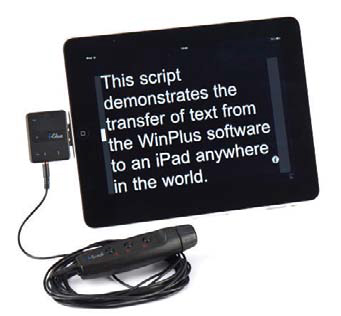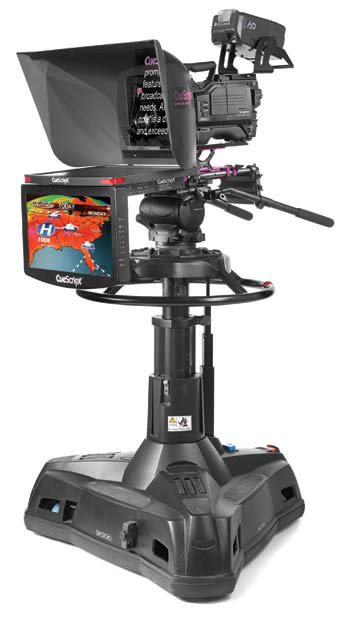Putting a New Spin on Prompters

Autoscript WinPlus Remote
SEATTLE—The physical basics of teleprompting are pretty much the same as they were in the 1950s, when news anchors and political candidates began reading scripts while staring directly into the camera’s lens. A prompter consisted (and consists) of a monitor beneath the lens that projects the text onto a beam-splitting half-silvered mirror placed in front of the lens.
But through the years, computer-generated text replaced paper scripts taped together and scrolled on a conveyor belt under the camera, and flat panel screens replaced CRT displays. Year-by-year prompter makers continue to evolve their products to take advantage of the forward march of technology in areas such as IP, network and cellular connectivity.
ANYTIME, ANYWHERE
In the studio, prompter video is easily distributed to camera-mounted monitors used to display scripts to the anchors. Sending that video out to prompters in the field and around the world is more difficult. That’s why Autocue, with its QBox Intelligent Scroll Engine sends the text and scrolling control data via Internet protocol rather than as video.
“The QBox on location takes that text and control information and generates the video locally,” said Aaron Brady, managing director for Autocue in New York. “That allows us to keep the latency really, really low.”
In a recent coast-to-coast production with anchors in Stamford, Conn. and Los Angeles, Brady said the delay was just 6 milliseconds, far less than if the prompter copy was sent as video over IP. In that deployment, scrolling was handed off between prompter operators at each location when the anchor at that site was speaking. Scrolling controlled from the other side of the country was visible on the prompter across the country. The system is not limited to just two locations.
In April, Vitec Videocom, in Bury St. Edmonds, United Kingdom, which owns Autoscript, announced plans to acquire Autocue. With two prompting companies now, Vitec Videocom CEO Matthew Danilowicz said that Autocue will complement its Autoscript business. “It will enable us to diversify our product base by extending our range of prompting solutions from broadcast to pro-videography,” he said. “This means our provision to support independent videographers, in particular, will be given a significant boost.”
The transaction is expected to be complete in July.
IPAD DELIVERY
Autoscript is taking a different tact to distribute scripts to prompters worldwide, using its WinPlus Remote, an iOS-based teleprompting system. “What Autoscript has launched this year is a method of delivering scripts to an iPad anywhere in the world,” said Simon Clark, business development manager, prompters EMEA and Asia at Vitec Videocom.
“Our new product, WinPlus Remote, actually includes our standard software, so without having to save or upload or anything, any changes to the script, back at studio, back at base, are automatically uploaded to an FTP site, and then anywhere in the world. And as long as the iPad has a connection, you can download the latest scripts instantly.”

CueScript launched its CSM17 17-inch LED High Brightness HD-SDI Prompter Monitor at the NAB Show. He pointed out that downloading the latest scripts from the studio without operator intervention is essential where a small crew on location is busy setting up the camera and liveshot, actually covering the story.
WinPlus Remote works in conjunction with iOS app picoPrompt and the iScroll Hand Control package, both created by Teleprompting Techniques, as well as third-party prompting solutions.
NEW LAUNCH
CueScript, founded by a pair of teleprompter veterans, Brian Larter and Michael Accardi, is a new entry to the teleprompting business. They tout the advantages of starting with a clean slate when developing the CueScript system, which will be reflected in their prompting suite to be launched this summer.
“We’re finding a lot of news operations want to go on location, they want to present from wherever, but they want the features they have in the newsroom,” said Larter, managing director of CueScript in Fairfield, Conn. “So they want real-time prompting, real-time changes. With our new suite of software, it doesn’t matter where you are in the world. If you’ve got any kind of connection you can prompt with no latency.”
Larter added that the company plans on “putting all sorts of intelligence into the prompter out on location, so the cameraman— or whoever will get out on location— sets the camera up, sets the teleprompter up, plugs it all in and forgets about it. You take control of the prompter in Atlanta or New York or wherever.”
PAN AND TILT PROMPTER
Mirror Image Teleprompters looked at the growing use of small PT (pan/tilt) cameras in use in news bureaus and other locations, and came up with a prompter assembly specifically designed for these new and popular, all-in-one robotic pan and tilt cameras.
“The teleprompter’s fixed, and the camera moves within this large hood assembly,” said J. T. Meidl, founder of Mirror Image Teleprompters in Oshkosh, Wis. “You’re somewhat limited to your pan and tilt, but for a lot of the applications, you’re sitting at a counter, standing in front of the weather map or at a news bureau, and that’s fine. You just can’t swing all the way around the studio.”
The company’s Pan/Tilt Series system features an HD-wide angle glass beam splitter mirror that allows for maximum camera movement. The nylon and metal enclosure keeps ambient light off the mirror, and the system incorporates a 15-inch SVGA color LCD monitor and its EZPrompt prompting software.
HDMI CURVE
Sometimes the manufacturers of a component will throw a curveball to prompting system makers, and that’s happened with some recent laptops and video display panels. “Up until now, you just fed the VGA out of a laptop and into the monitors,” said Raymond Blumenthal, vice president for broadcast sales at Listec Teleprompters, a division of The Tiffen Company. “But we started getting customers with laptops that only output HDMI, and I’m sure down the road that we’ll get calls for HDMI monitors.”
Being forced into using HDMI rather than VGA to move video from laptop to flat panel display is actually where most broadcasters are moving toward in an all-digital plant. VGA is analog where HDMI is digital. Blumenthal said Listec will offer HDMI as an extra.
“If somebody owns one of our teleprompter boxes right now, they can do a retrofit to it that will protect their existing prompter investment, turning it into a digital prompter,” he said. “In our current systems, we have holes already punched for the in and out connectors, labeled digital in and digital out. And if they have to go digital later, they can send it back to us and we can update it.”
Could the basics of teleprompting be up for a change in the near future? There are suggestions that a holographic display of scripts might follow anchors as they walk around the studio, or that they’ll read scripts off their Google Glasses. Stay tuned.
Get the TV Tech Newsletter
The professional video industry's #1 source for news, trends and product and tech information. Sign up below.
